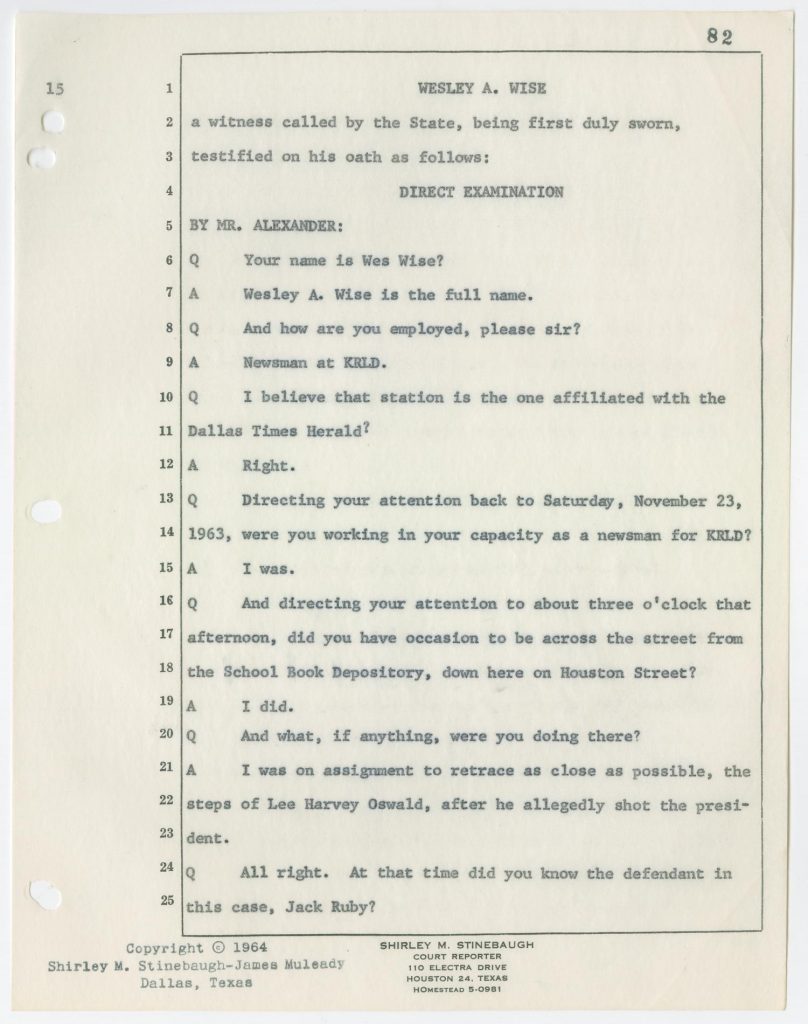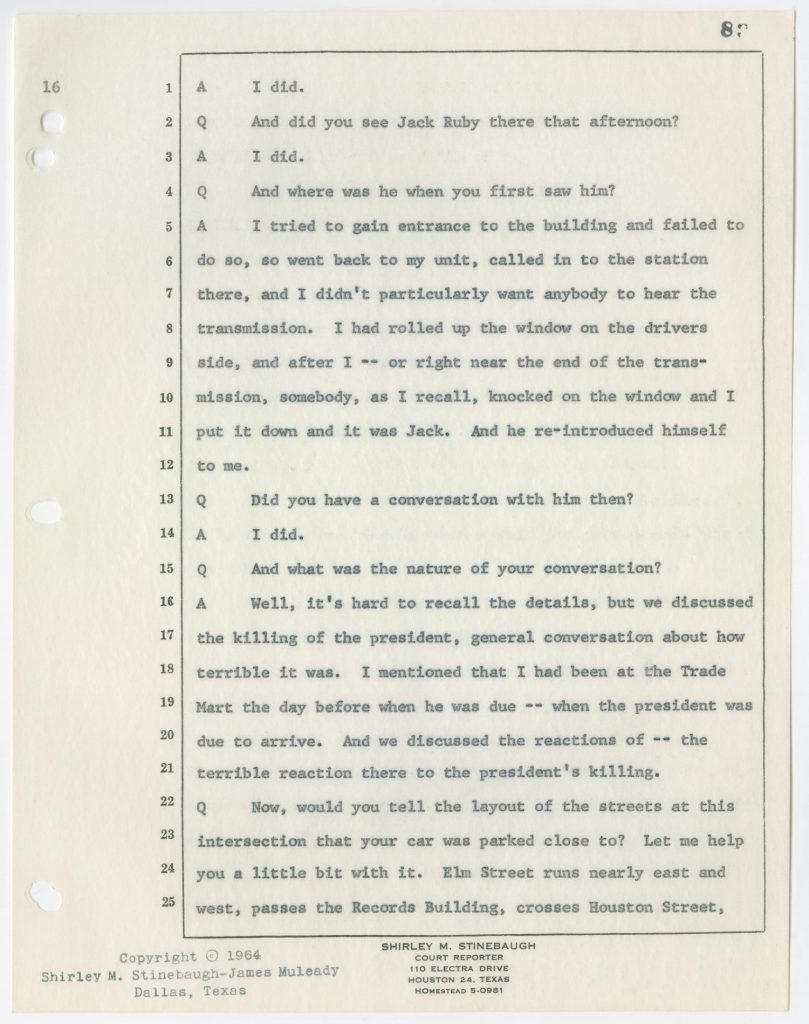The Jack Ruby Trial for murdering Lee Oswald took place between 4 March and 14 March 1964. The following image shows the participants:
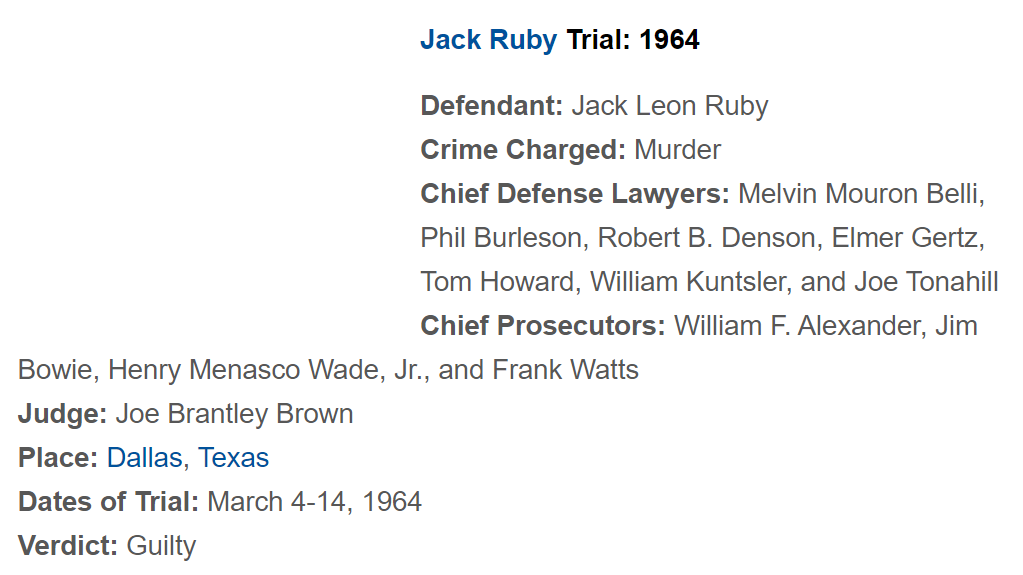
From the beginning, Melvin Belli tried to paint Ruby as “loco”, attempting to make it an open and shut case based on his diagnosis of Ruby’s state of mind on 24 November 1963, as a result of a rare variant of epilepsy which could be temporary or permanent. From the prosecution side, the unwritten rule was to not bring any witness who might have associated Ruby with Lee Oswald, of which there were plenty. Belli also tried unsuccessfully to change the venue for the trial, having noted that no juror had missed Ruby shoot Lee Oswald on T.V. that morning. As a result, the prosecution, led by Henry Wade and Bill Alexander, was able to obtain a quick guilty verdict.
Once the trial ended, the defense appealed and the verdict was tossed out with the order of a retrial. From encyclopedia.com/law, we get the following synopsis:
Judge Joe Brown’s charge to the jury and defense and prosecution closing arguments went to well past 1:00 a.m. on Saturday, March 14. That afternoon, the jury deliberated for only two hours and 19 minutes before finding Jack Ruby “guilty of murder with malice, as charged in the indictment, and [we] assess his punishment at death.”
More than two and a half years of appeals followed. On October 5, 1966, the Texas Court of Criminal Appeals found that Ruby’s statements to police immediately after shooting Oswald should not have been admitted as evidence and that he should have been granted a change of venue.
A new trial was scheduled for Wichita Falls, Kansas. However, when that city’s sheriff traveled to Dallas to get Ruby in December 1966, he found him too sick to move. Jail doctors had not taken Ruby’s stomach complaints seriously, but Parkland Hospital physicians now found cancer in his liver, brain, and lungs. He died on January 3, 1967, before being able to receive a new trial.
One of the authors to become interested in the Ruby Trial Transcript was Mark Shaw. He became engrossed in the Ruby trial because of his research on Dorothy Kilgallen and her untimely and suspicious death by “suicide” — she happens to be on the long list of convenient deaths which characterize the JFK assassination investigation. Those familiar with the Kilgallen story note that she was the only reporter to have been allowed to spend eight minutes (Shaw p 72, 74) alone with Ruby after which she publicly stated that she was close to “breaking the case wide open”. Until around 2017, it appears the trial transcripts had never been released or examined in their entirety by historians, researchers, or investigators (certain select passages were published by the Warren Commission as CE2405-CE2013 in volume 25). Based on his research, Mark has declared the transcripts as the smoking gun on the assassination which according to Mark, goes well beyond conspiracy, where books that had previously been published without this new information might as well be tossed into the trash bin. He also fiercely denounces the charade run by the so-called 6th Floor Museum in Dallas as the main purveyor of the lone-nut Oswald did-it disinformation campaign which has been so thoroughly disproved and discredited in the 21st century. [The author happens to agree with his stance regarding the house that Larry Dunkel built.]
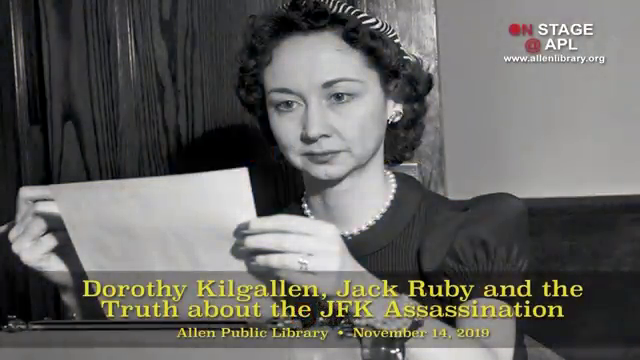
During his research, a collaborator made available to him thousands of pages of the missing trial transcript. Mark went over the entire collection, integrating several passages into his presentation. Even though he presents compelling new information on Ruby’s whereabouts before, during, and after the assassination, it is clear from looking at the entire collection, that there certainly remains a lot of “meat on that bone” which should entice researchers to go back and reinterpret based on new information that has come out over the years. For example, before the transcripts became available, we never knew the entire cast of witnesses brought by the prosecution team. To wit:
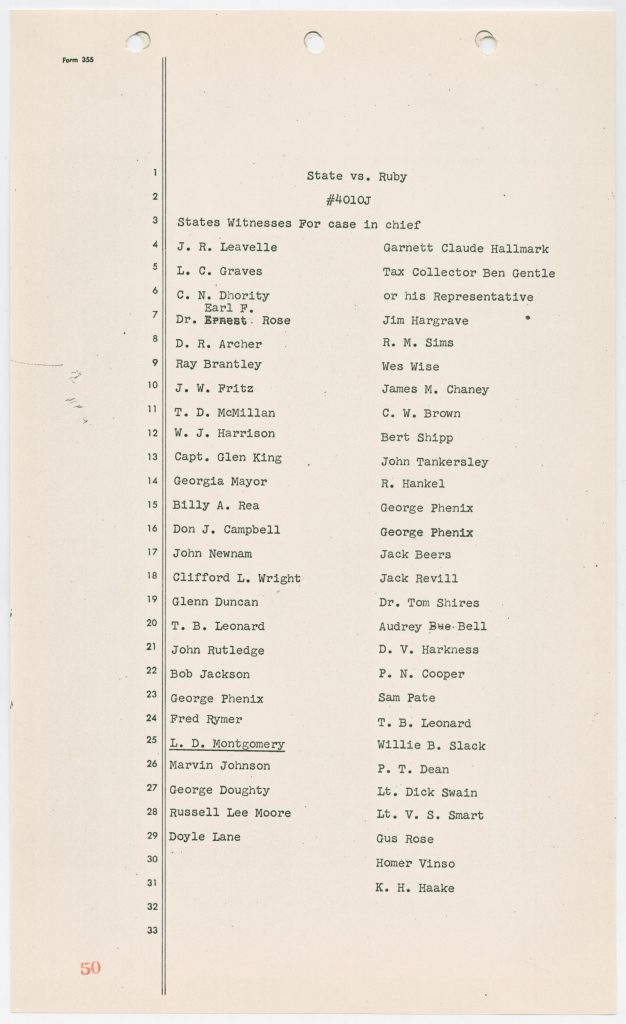
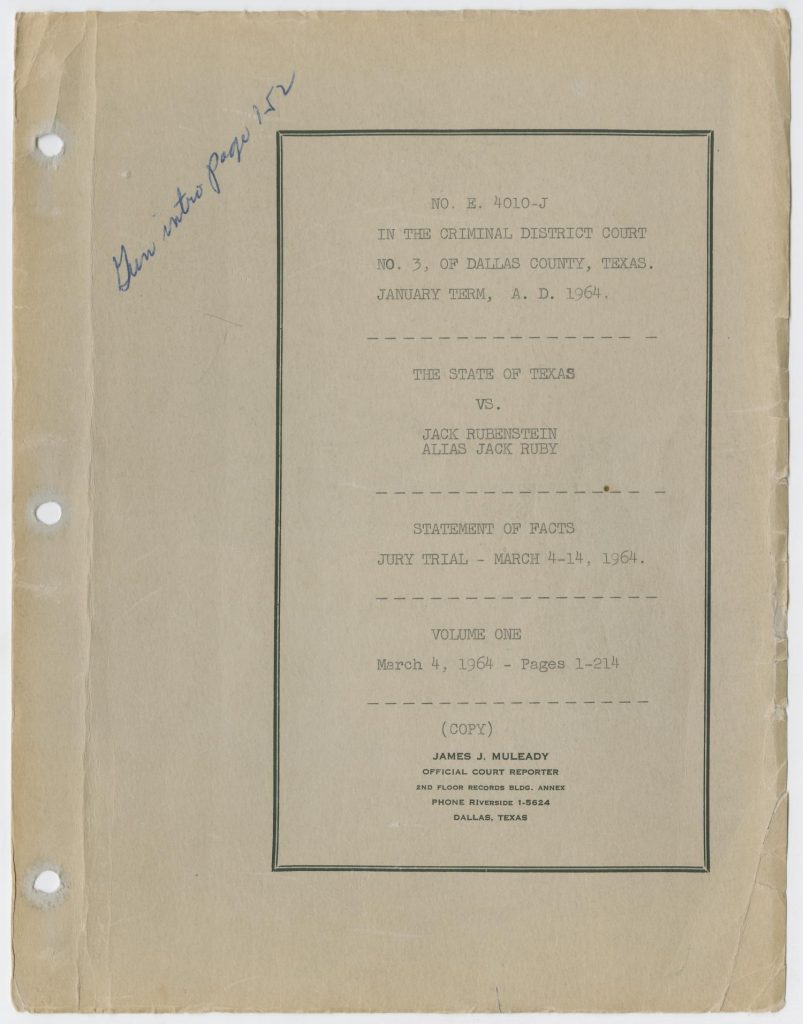
One such case of reinterpretation happens to be related to a blog post by yours truly published here (and in my book) six years ago on the experiences of Jerry Coley and the pool of blood. In his interview with Len Oceanic of Black Ops Radio, he mentioned two co-workers of his at the Dallas Morning News Advertising Department by the names of Don Campbell and John Newnam. Don, Jerry, and Jack Ruby had started their day that morning in the cafeteria having coffee at 8:30 AM!
The following are the first four pages of Don Campbell’s testimony. Note that Coley was conspicuously absent from his testimony and was certainly not brought in as a witness given what he and his other co-workers Charlie Mulkey and Jim Hood knew about the pool of blood at the top of the country steps of the North Pergola, AND the fact that Hood had taken photos of it that were confiscated by the FBI the following Monday. Furthermore, Coley’s name had been in the news when Hugh Aynesworth wrote an article that reported Ruby that Friday morning having coffee with Coley and not Campbell! The article cited “Coley at the News”. That’s why the FBI came looking for Jerry the following Monday morning, not Campbell. The prosecution had to tread very carefully around Don Campbell’s testimony:
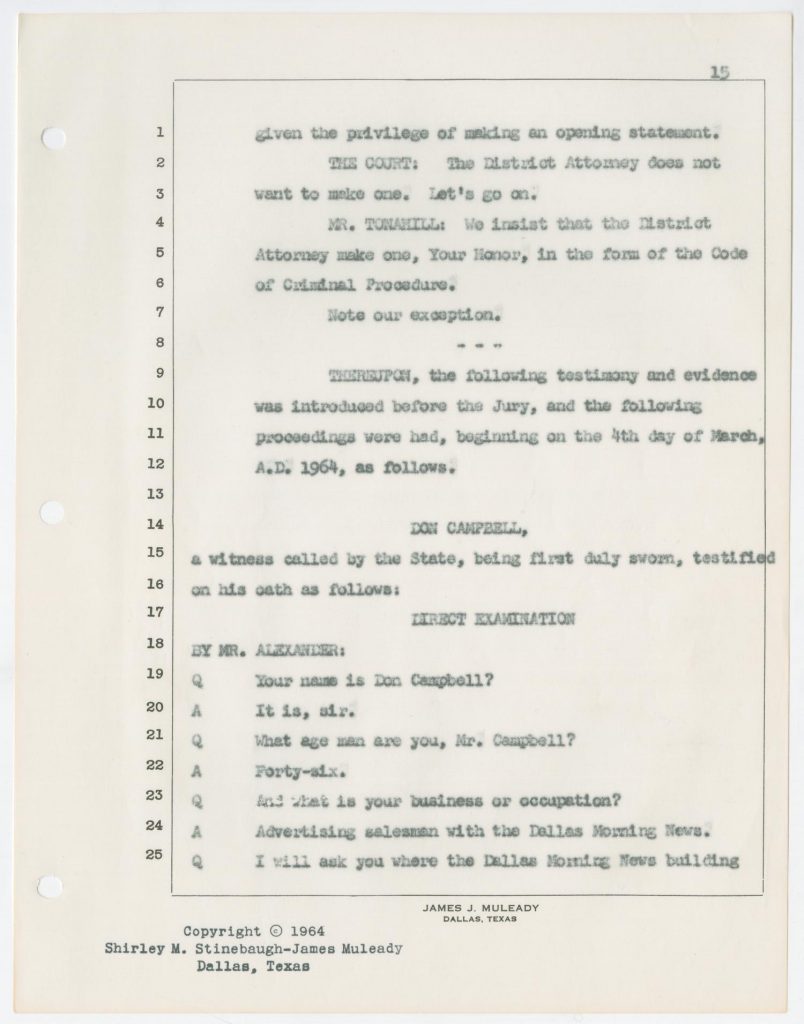
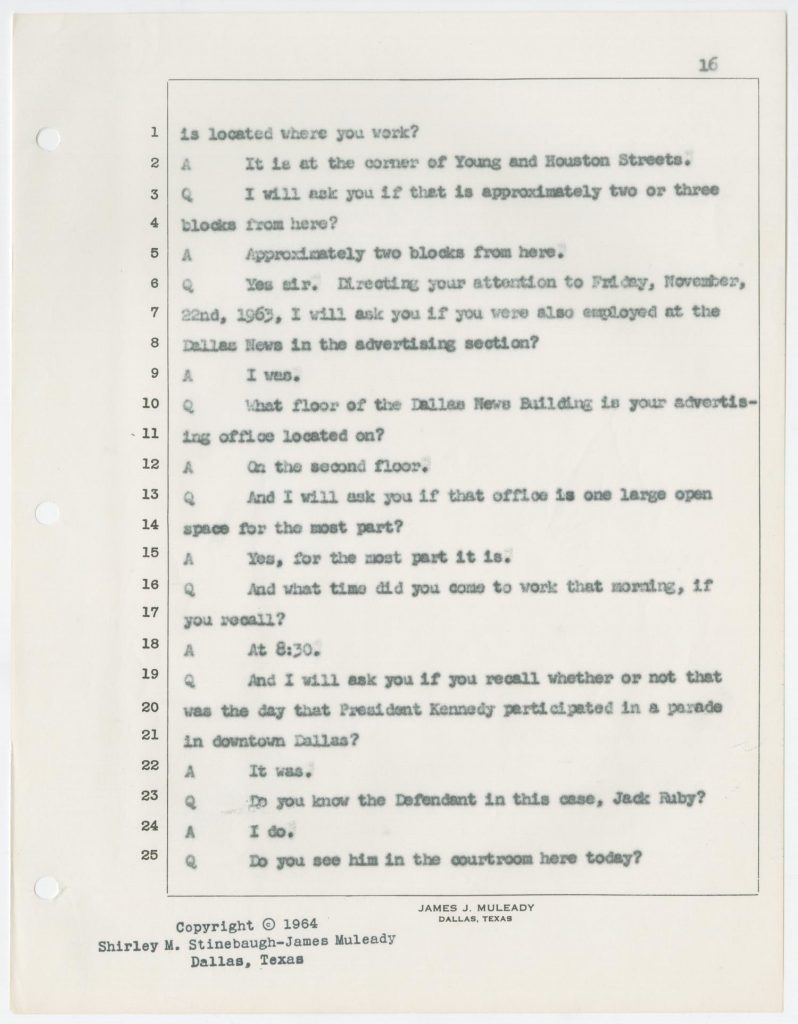
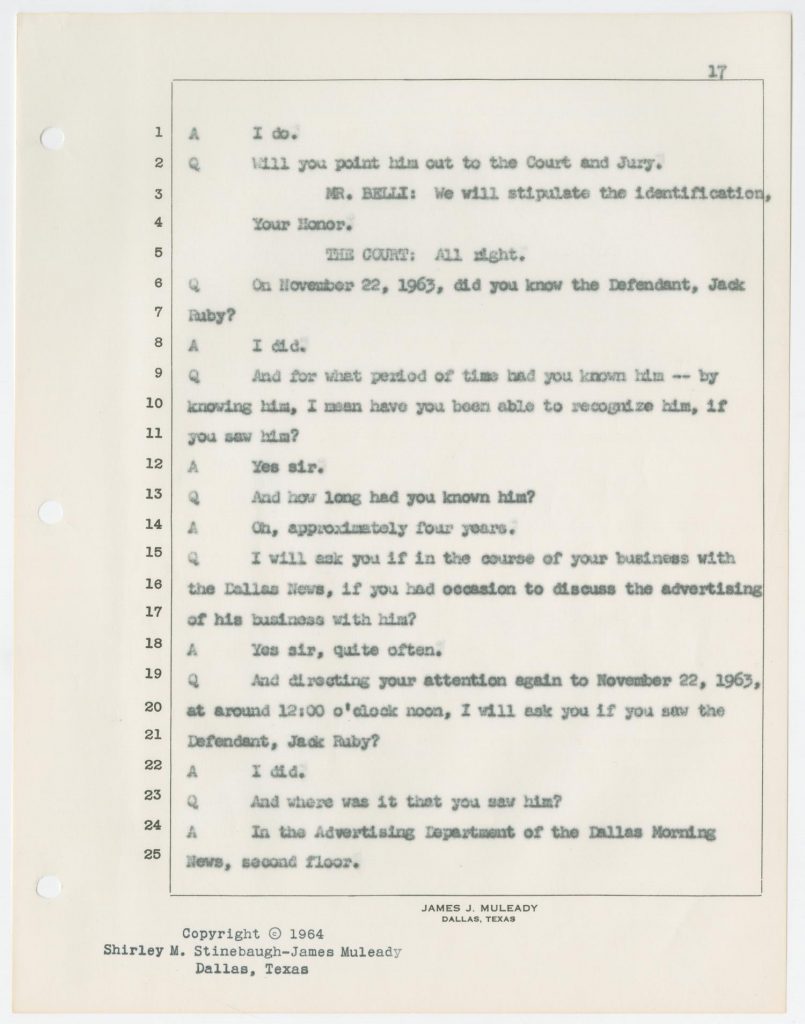
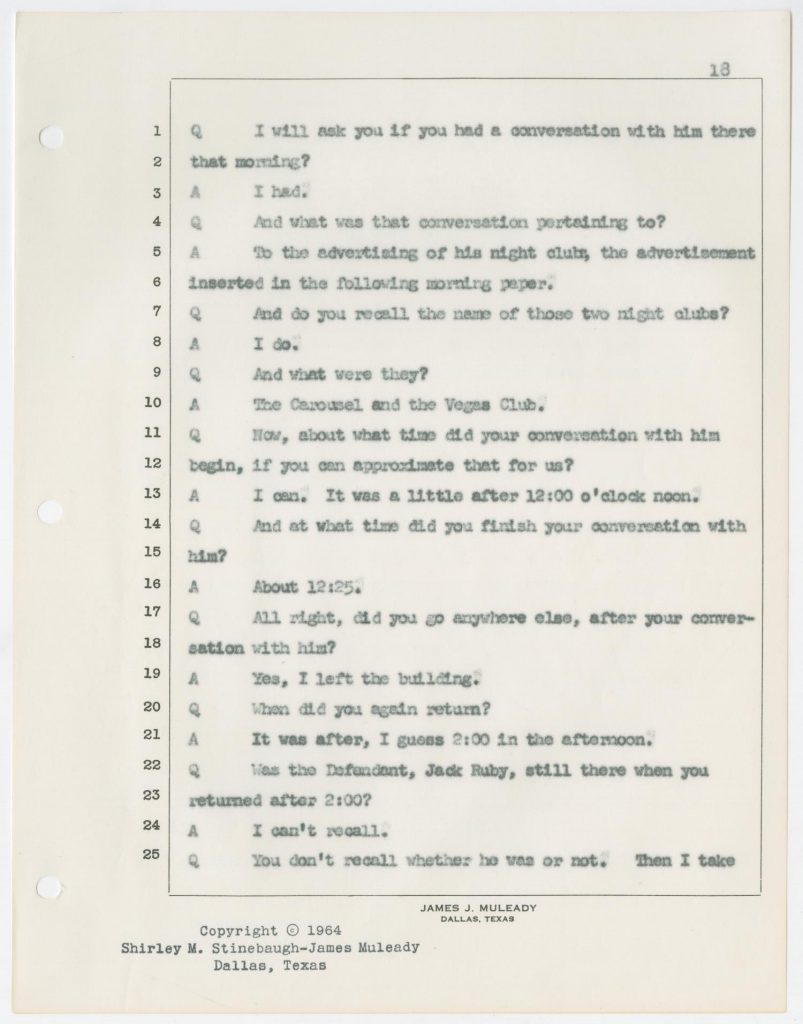
Both Campbell and Newnam had been interviewed by the FBI on 4 December 1963. Coley was never formally interviewed by the FBI. In fact, he was told to forget everything he witnessed and shut up, while his wife was receiving threatening phone calls over his being mentioned in the Aynesworth article that Monday morning. Here is Newnam’s FBI interview dated 4 December 1963:
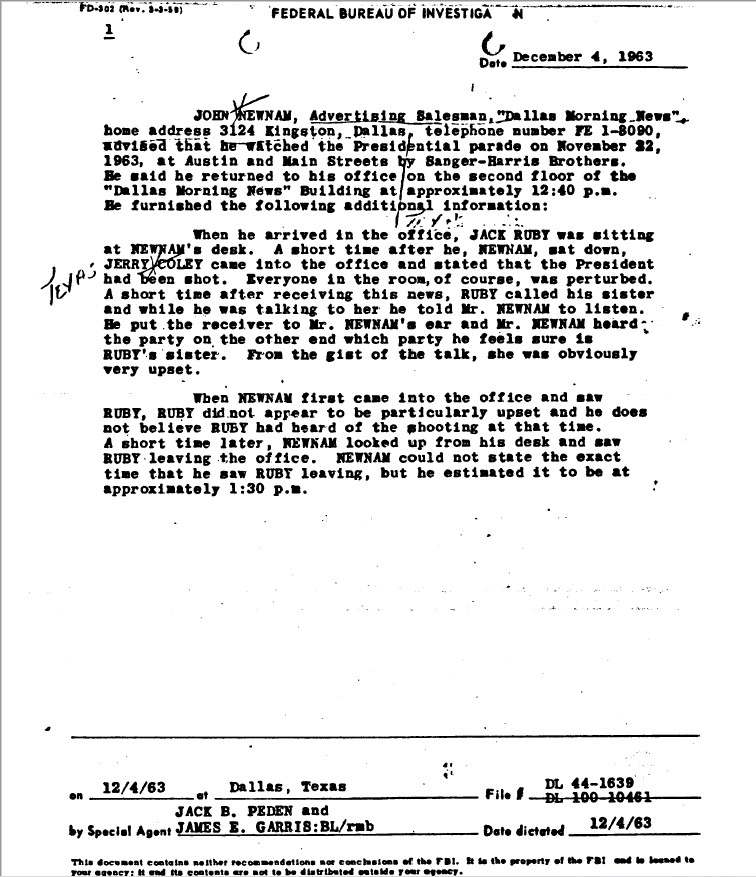
Both had left the Dallas Morning News building right before 12:25 PM to watch the parade outside at the corner of Main and Austin (pg 36), which could also be seen from afar from the Northwest corner of the DMN building.
Similarly, Coley’s co-worker John Newnam was called by the prosecution:
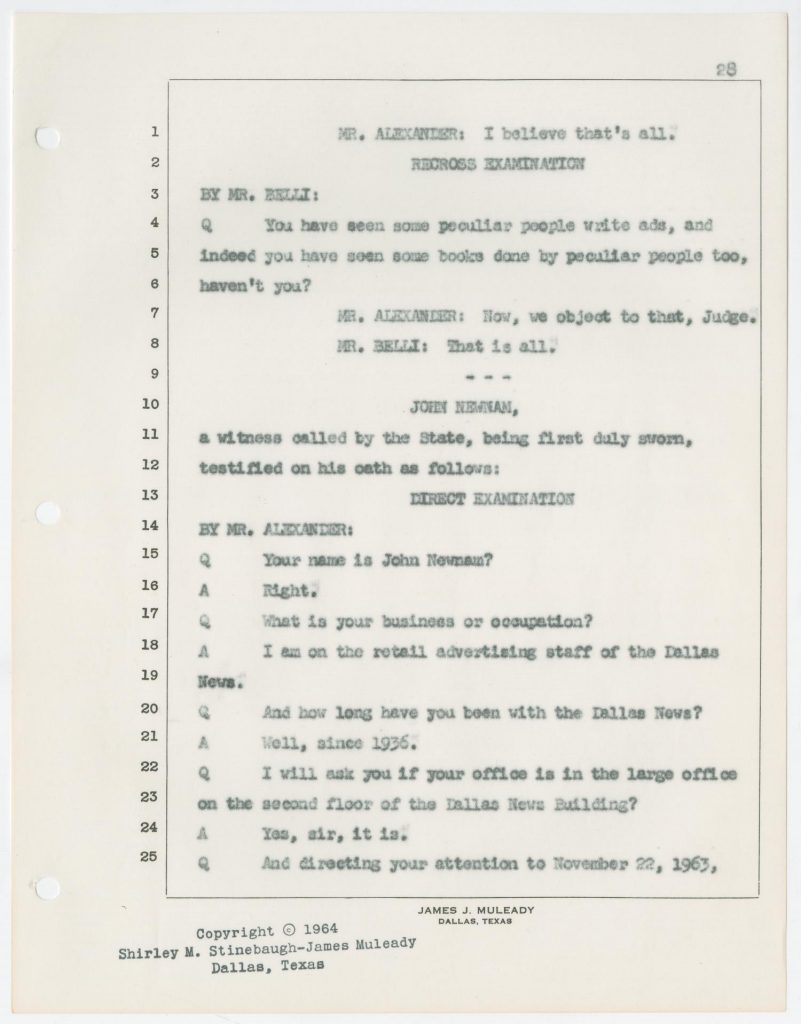
An interesting detail by Newnam tells us that he returned to work by 12:40 PM and at the time did not know the President had been shot. Upon his return, he found Ruby was still at the advertising department where he worked, sitting at his desk, (a detail he had already reported to the FBI in the report shown above). Jack Ruby found out about the successful hit on JFK when Coley burst into the office with the news, and later by watching TV at the Dallas Morning News, where a small TV set had been tuned into the news that afternoon! He did not leave until past 1:30 PM. Was Ruby creating an alibi making sure he was at a specific and verifiable time and place during the crucial time of the assassination?
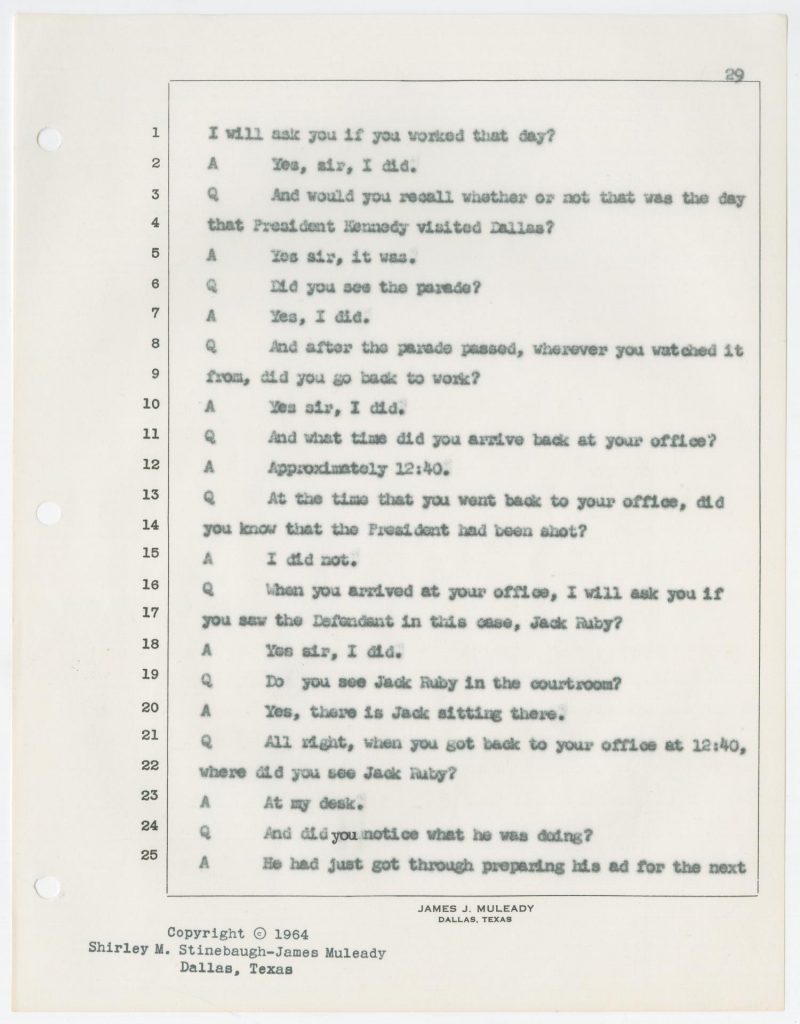
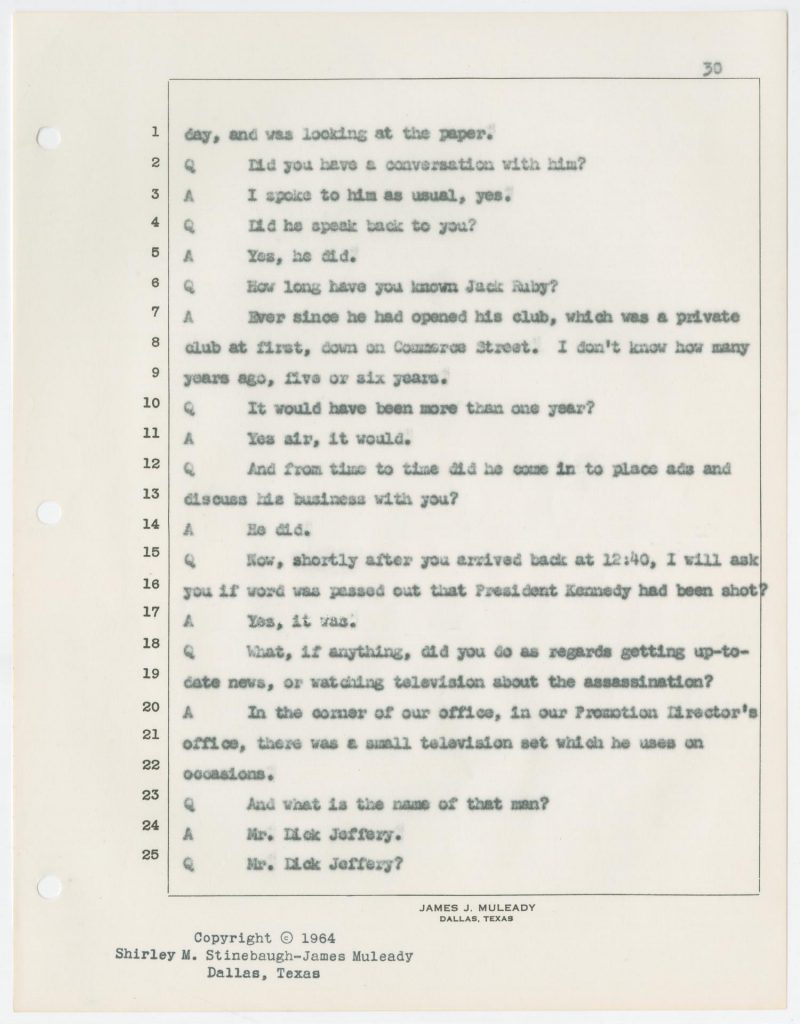
Page 36 not only fixed Newnam’s position at the time of the assassination at Main and Austin, but it also established how long it would take to walk back to the DMN building from that point:
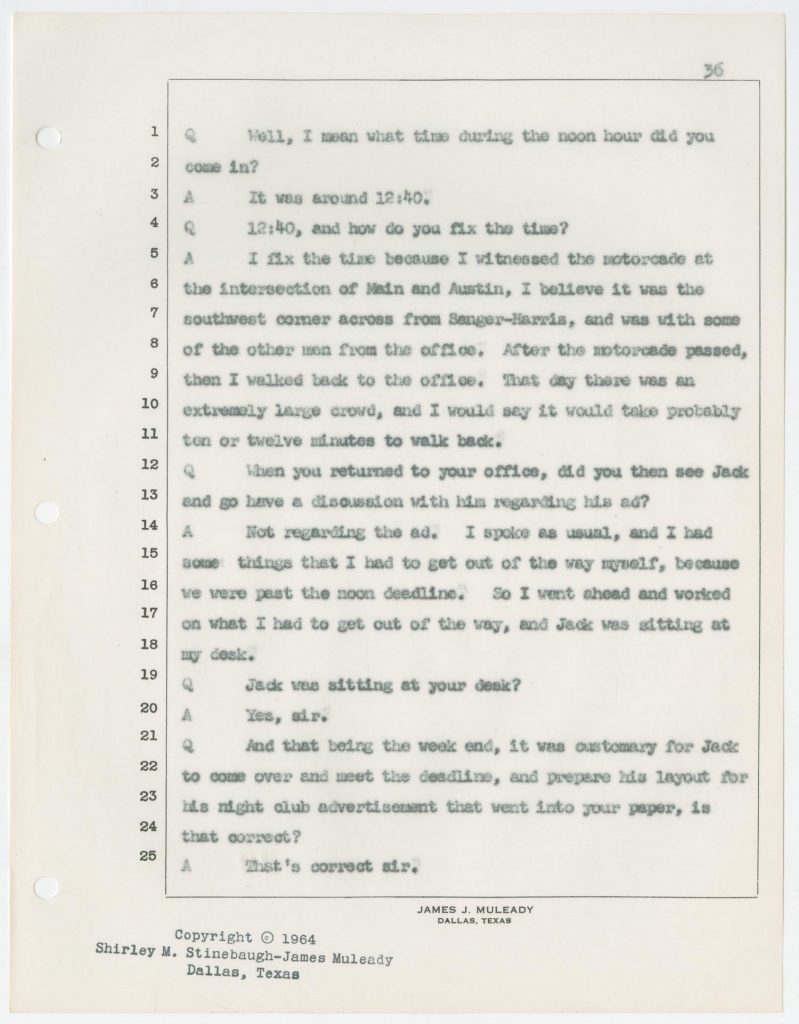
This, of course, comes in handy when considering the possibility of James “Ike” Altgens making it back to the DMN building from much farther away at the scene of the crime on Elm — where he was captured in many photos hanging around Dealey Plaza well after the assassination — in order for his Altgens6 to make it onto the wire services at 12:57 PM (FBI) or 1:03 PM (Warren Commission).
Making like a reporter
Another interesting witness seldom mentioned was Garnet Claude Hallmark, who ran the Allright Parking business at 1208 Commerce.
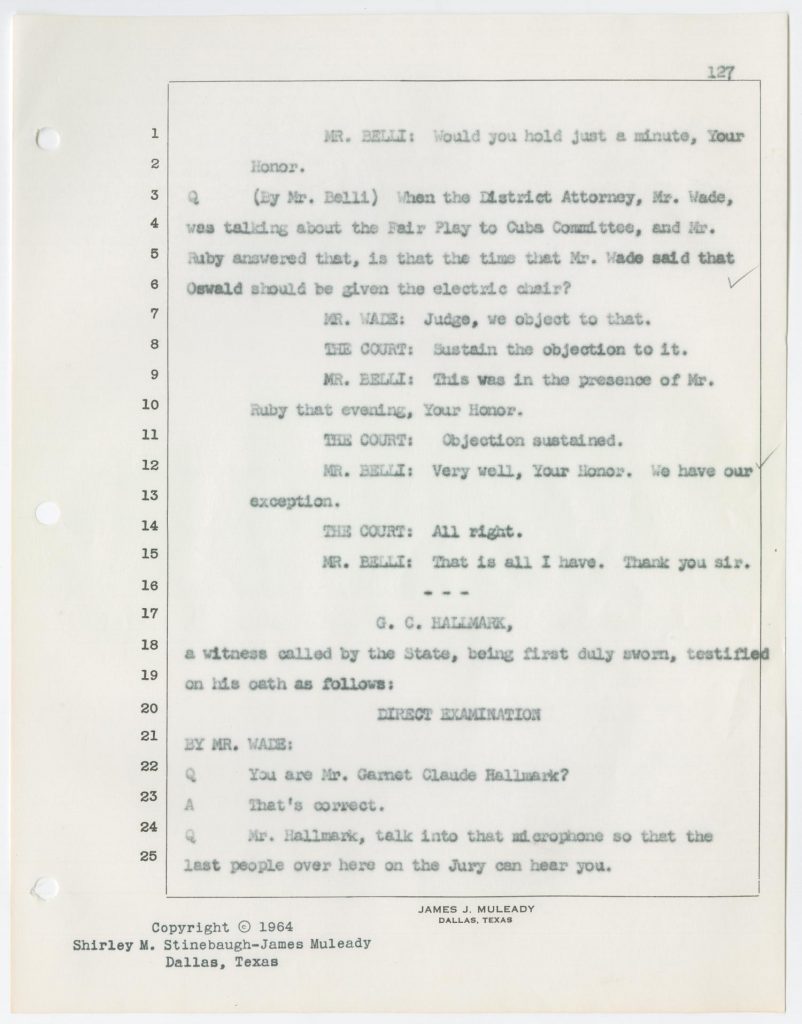
Ruby showed up at his place of business to borrow the telephone on the afternoon of the 23rd. According to Hallmark, Ruby made two phone calls. His attorney Joe Tonahill wanted to make sure the second phone call was brought into the record. Tonahill also wanted to establish that Jack had been roaming the halls of City Hall playing the part of a reporter and mixing in with the many reporters who had arrived in Dallas to cover the assassination.
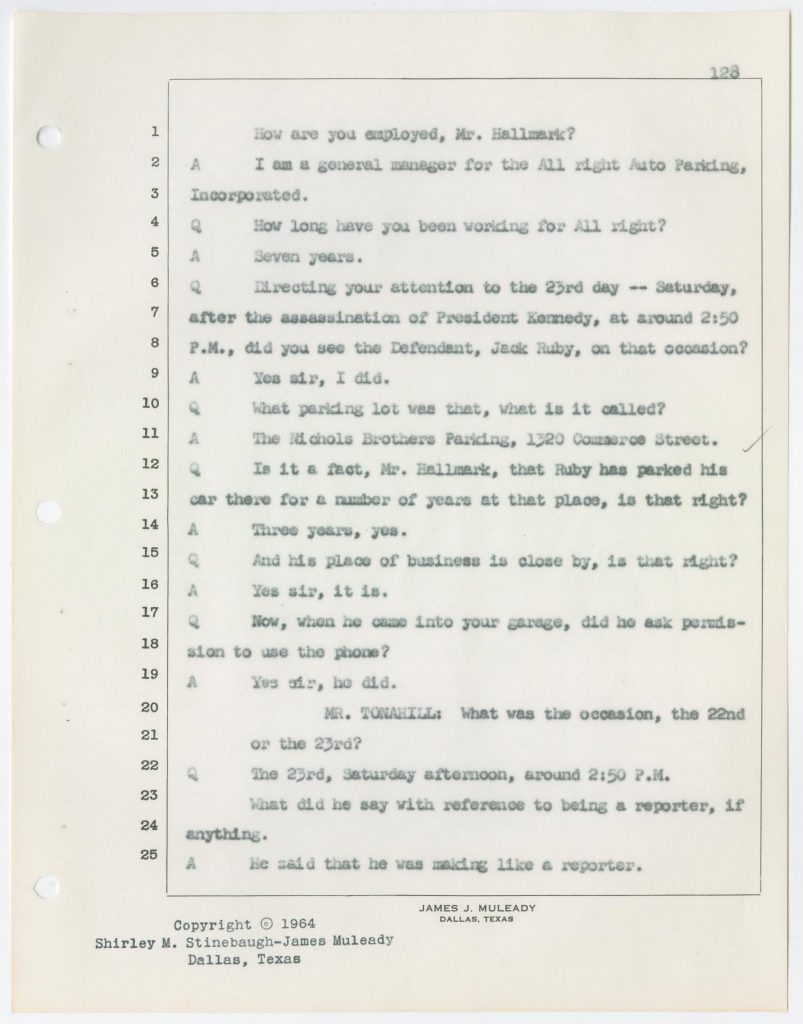
The phrase “making like a reporter” was mentioned twice, which of course made reference to Ruby’s known presence at City Hall the night before where he even corrected Henry Wade when he mentioned Lee’s involvement in the “Pro Cuba Committee” — and Ruby responding that it was the Fair Play for Cuba Committee:
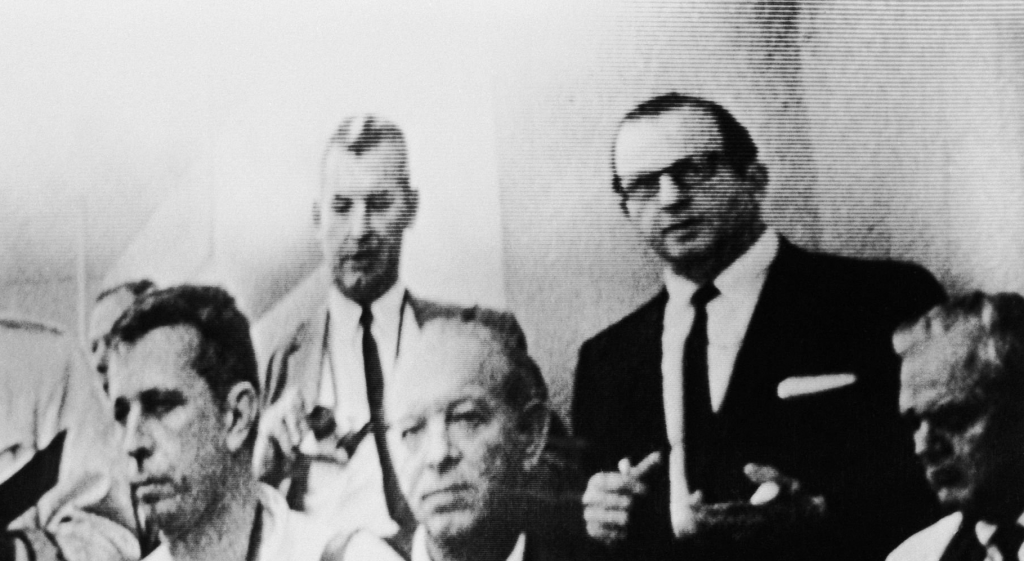
Ruby asked for Wes Wise
Tonahill then made sure that a Wes Wise-Jack Ruby connection was presented to the jury for consideration:
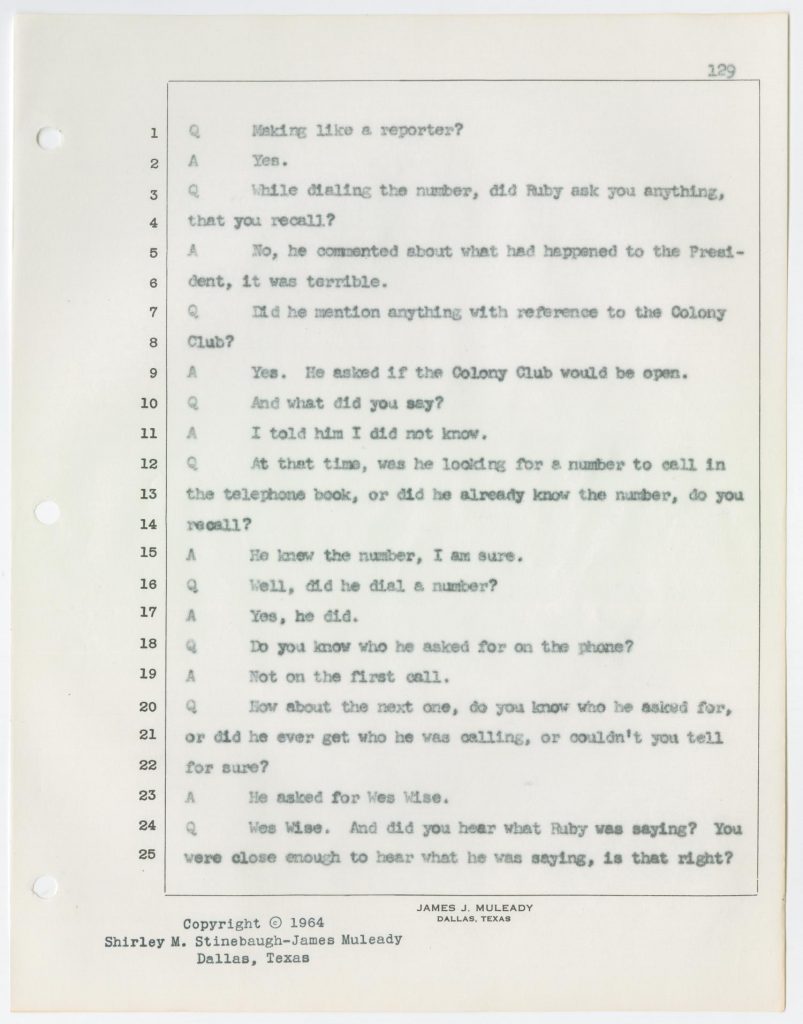
He would be there
Tonahill appeared to continue to defend Ruby’s interests, and at this point drew attention to the fact that as witnessed by Hallmark, Ruby told whoever he was talking to that “He would be there”. Then inexplicably he changed the subject to making change for a $10 bill. But the gist of the testimony appeared to show that Jack was scouting the Dallas Police Department on Main and Houston attempting to find out exactly when the Oswald transfer from City Hall to the County Jail at the DPD would take place. With his connections in the DPD, he would have been able to find out and transmit the information to Wise, especially if there was some kind of delay as seen here:
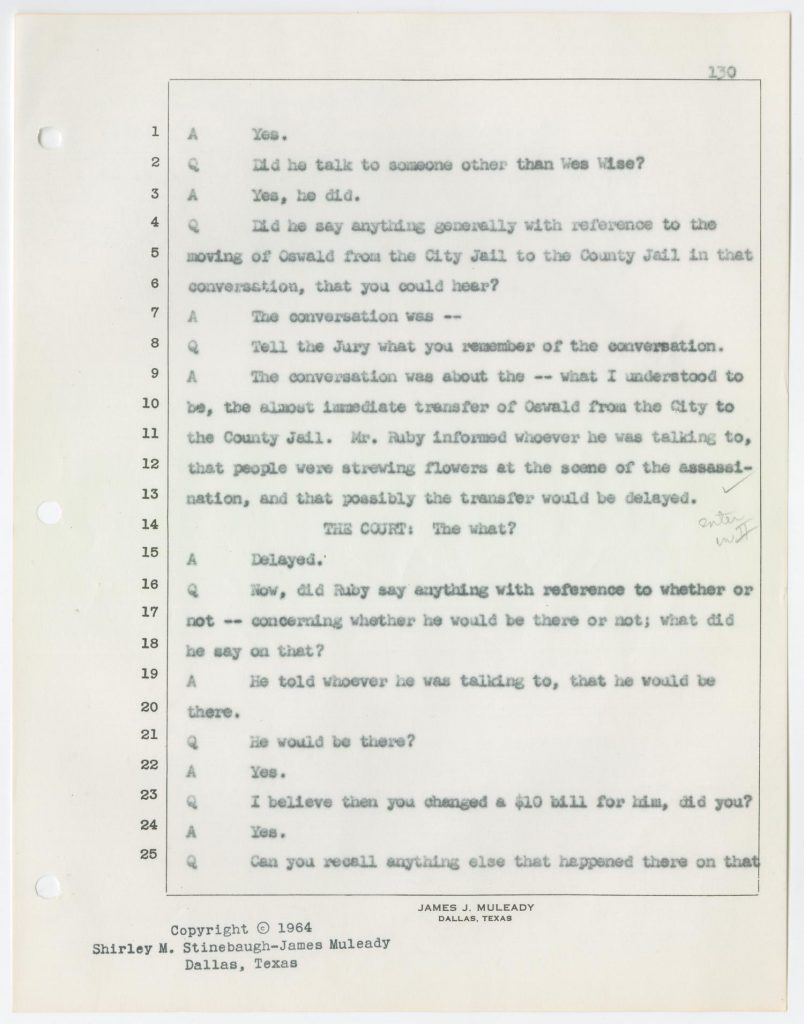
The Dallas Police Department, however, was ready for anything Hallmark might have said to involve Wise with Ruby. This very rare letter from Detective L.D. Stringfellow to Captain Gannaway speaks for itself and was written two weeks before the trial. It also established the Wise-Ruby encounter at 1:00 PM!
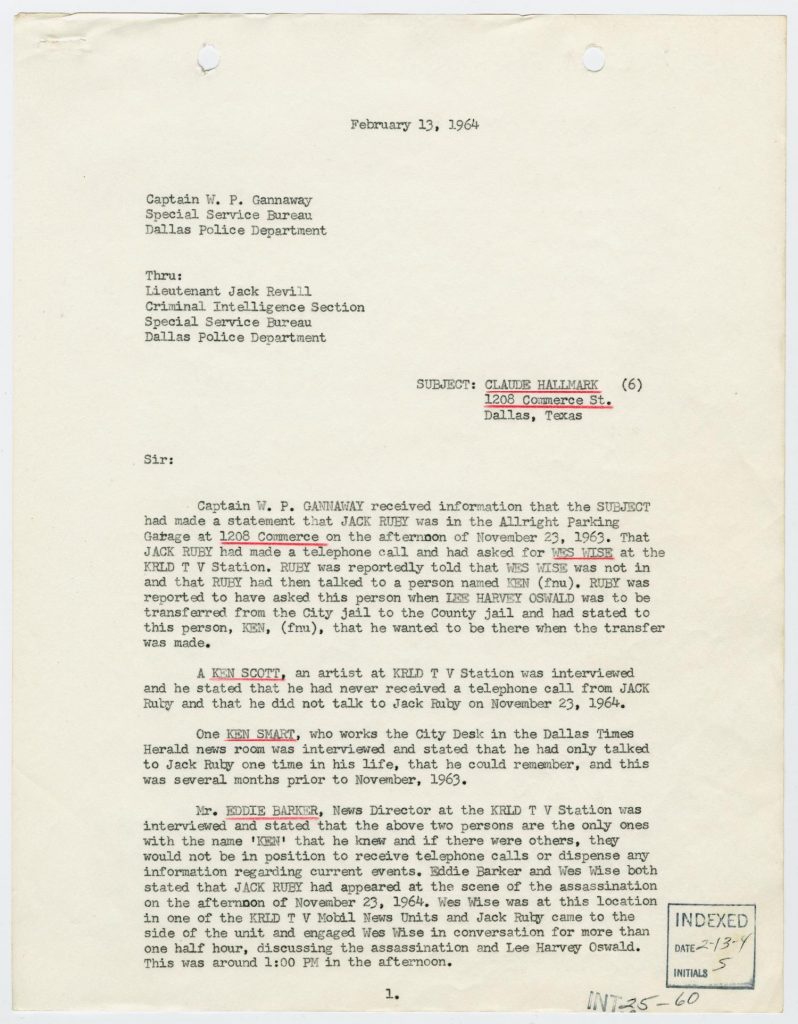
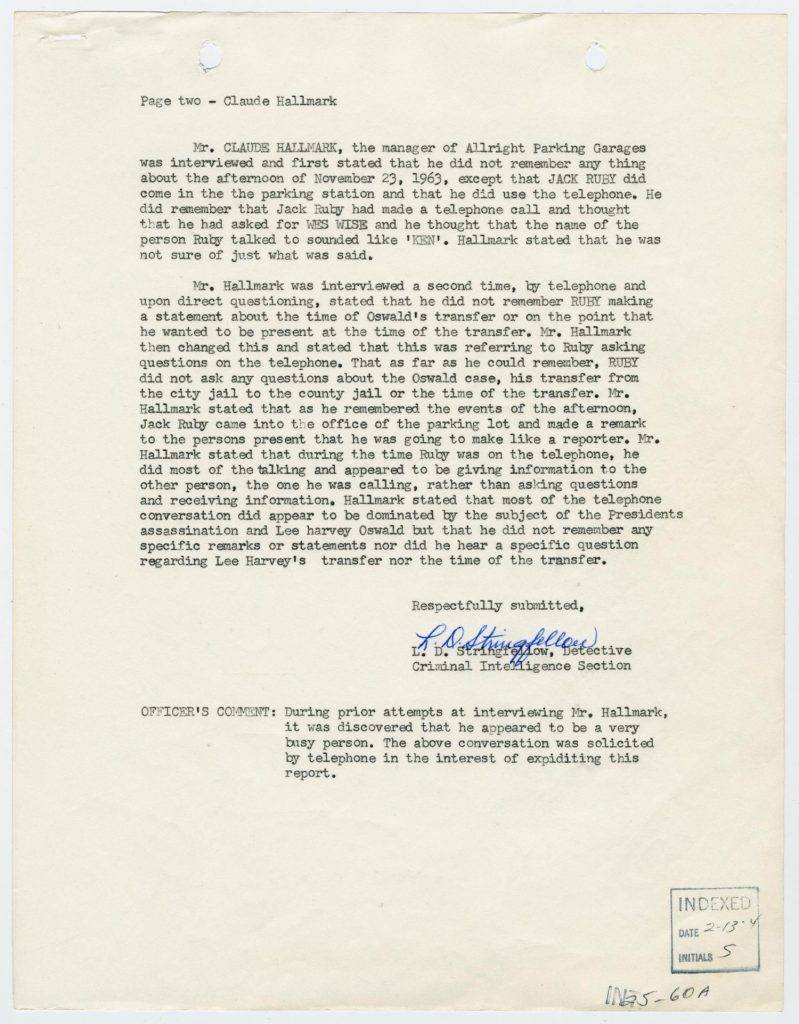
The letter attempted to change history by discrediting Hallmark’s Wise-Ruby connection before it came up in court. To Hallmark’s credit, he never deviated and testified the truth about the conversation they had from his place of business at 2:50 PM on 23 November 1963.
Enter Wes Wise
A little background on Wes Wise regarding the JFK assassination. On 22 November, future mayor of Dallas Wes Wise was involved in a curious second Oswald shell game reported by James Douglass in “JFK and the Unspeakable” (pg 284-286)
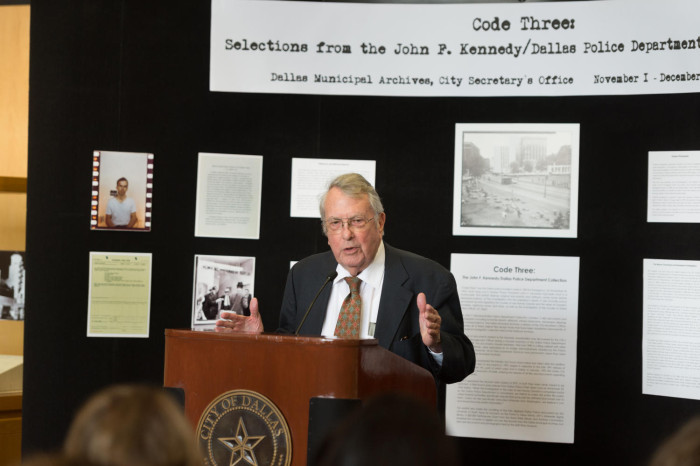
Bringing news sportscaster Wes Wise into this was a no-no that had to be rectified. When Wise testified, he made sure to portray Ruby as a news “groupie” who just wanted to be seen with important people. The encounter which had been documented to have been at 1:00 PM by Detective Stringfellow, was now changed to 3:00 PM by Bill Alexander, apparently to compete with the 2:50 PM time set by Hallmark above. Here is a portion of his testimony:
